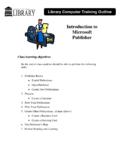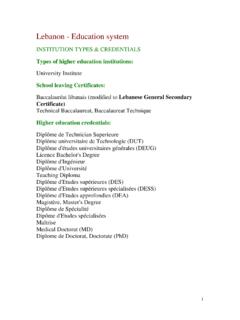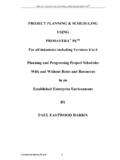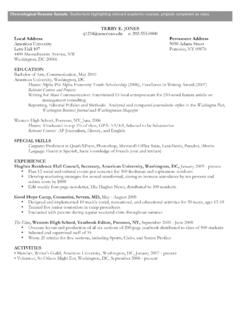Transcription of Teaching and Learning with Technology: Effectiveness of ...
1 Teaching and Learning with Technology: Effectiveness of ICT Integration in Schools Simin Ghavifekr, Wan Athirah Wan Rosdy Faculty of Education , University of Malaya, Malaysia, To cite this article: Ghavifekr, S. & Rosdy, (2015). Teaching and Learning with technology: Effectiveness of ICT integration in schools. International Journal of Research in Education and Science (IJRES), 1(2), 175-191. This article may be used for research, Teaching , and private study purposes. Any substantial or systematic reproduction, redistribution, reselling, loan, sub-licensing, systematic supply, or distribution in any form to anyone is expressly forbidden. Authors alone are responsible for the contents of their articles. The journal owns the copyright of the articles. The publisher shall not be liable for any loss, actions, claims, proceedings, demand, or costs or damages whatsoever or howsoever caused arising directly or indirectly in connection with or arising out of the use of the research material.
2 International Journal of Research in Education and Science Volume 1, Issue 2, Summer 2015 ISSN: 2148-9955 Teaching and Learning with Technology: Effectiveness of ICT Integration in Schools Simin Ghavifekr*, Wan Athirah Wan Rosdy Faculty of Education, University of Malaya, Malaysia Abstract Integration of Information, Communication, and Technology (ICT) will assist teachers to the global requirement to replace traditional Teaching methods with a technology-based Teaching and Learning tools and facilities. In Malaysia, ICT is considered as one of the main elements in transforming the country to the future development. The Ministry of Education, through the latest Education Blue print (2013-2025), insights the importance of technology-based Teaching and Learning into the schools national curriculum. This study aims to analyze teachers perceptions on Effectiveness of ICT integration to support Teaching and Learning process in classroom.
3 A survey questionnaire was distributed randomly to the total of 101 teachers from 10 public secondary schools in Kuala Lumpur, Malaysia. The data for this quantitative research were analyzed for both descriptive and inferential statistic using SPSS (version 21) software. The results indicate that ICT integration has a great Effectiveness for both teachers and the students. Findings indicate that teachers well-equipped preparation with ICT tools and facilities is one the main factors in success of technology-based Teaching and Learning .. It was also found that professional development training programs for teachers also played a key role in enhancing students quality Learning . For the future studies, there is a need for consideration of other aspects of ICT integration especially from management point of view in regard to strategic planning and policy making.
4 Key words: ICT integration; Teaching and Learning ; Technology Effectiveness ; Education; Malaysia Introduction In this 21st century, the term technology is an important issue in many fields including education. This is because technology has become the knowledge transfer highway in most countries. Technology integration nowadays has gone through innovations and transformed our societies that has totally changed the way people think, work and live (Grabe, 2007 ). As part of this, schools and other educational institutions which are supposed to prepare students to live in a knowledge society need to consider ICT integration in their curriculum (Ghavifekr, Afshari & Amla Salleh, 2012). Integration of Information, Communication, and Technology (ICT) in education refers to the use of computer-based communication that incorporates into daily classroom instructional process.
5 In conjunction with preparing students for the current digital era, teachers are seen as the key players in using ICT in their daily classrooms. This is due to the capability of ICT in providing dynamic and proactive Teaching - Learning environment (Arnseth & Hatlevik, 2012). While, the aim of ICT integration is to improve and increase the quality, accessibility and cost-efficiency of the delivery of instruction to students, it also refers to benefits from networking the Learning communities to face the challenges of current globalization (Albirini, 2006, ). Process of adoption of ICT is not a single step, but it is ongoing and continuous steps that fully support Teaching and Learning and information resources (Young, 2003). ICT integration in education generally means technology-based Teaching and Learning process that closely relates to the utilization of Learning technologies in schools.
6 Due to the fact that students are familiar with technology and they will learn better within technology-based environment, the issue of ICT integration in schools, specifically in the classroom is vital. This is because, the use of technology in education contributes a lot in the pedagogical aspects in which the application of ICT will lead to effective Learning with the help and supports from ICT elements and components (Jamieson-Procter et al., 2013). It is right to say that almost all ranges of subjects starts from mathematics, science, languages, arts and humanistic and other major fields can be learned more effectively through technology-based tools and equipment. In addition, ICT provides the help and complementary supports for both teachers and students where it involves effective Learning with the help of the computers to serve the purpose of Learning aids (Jorge et al.)
7 , 2003). Computers and technology does not acts * Corresponding Author: Simin Ghavifekr, 176 Ghavifekr & Athirah as a replacing tools for quality teachers but instead they are considered as an add-on supplements needed for the better Teaching and Learning . The need for ICT integration in education is crucial, because with the help of technology, Teaching and Learning is not only happening in the school environment, but also can happen even if teachers and students are physically in distance. However, ICT integration is not a one-step Learning process, but it is a continual process of Learning that provides proactive Teaching - Learning environment (Young, 2003). ICT can be used in various ways where it helps both teachers and students to learn about their respective subject areas. A technology- based Teaching and Learning offers various interesting ways which includes educational videos, stimulation, storage of data, the usage of databases, mind-mapping, guided discovery, brainstorming, music, World Wide Web (www) that will make the Learning process more fulfilling and meaningful (Finger & Trinidad, 2002).
8 On the other hand, students will benefit from ICT integration where they are not bounded to the limited curriculum and resources, instead hands-on activities in a technology-based course is designed to help them to stimulate their understanding about the subject. It also helps teachers to design their lesson plans in an effective, creative and interesting approach that would result in students active Learning . Previous researches proved that use of ICT in Teaching will enhance the Learning process and maximizes the students abilities in active Learning (Finger & Trinidad, 2002; Jorge et al., 2003; Young, 2003; Jamieson-Procter et al., 2013). Hermans, Tondeur, Van-Braak, and Valcke (2008) have identified three main stages for ICT to be highly valued and regarded by the teachers; integration, enhancement and complementary. Integration approach is about implementing right use of ICT in particular subject area that involved complex concepts and skills to improve student s achievement and attainment.
9 Besides, the review of curriculum is also needed so that only related ICT resources and appropriate software will be installed for the main aims and objectives of curriculum to be achieved. Enhancement approach is about using ICT to give great emphasis on the topic introduced. For instance, microsoft PowerPoint can be used to present the topic in a very innovative and creative way that will lead into discussion and exchanging ideas and thoughts. Finally, complementary approach is when the ICT is used to aid and support the student s Learning . This approach allow students to be more organized and efficient in which they can take obtain the notes from computer, submit their works by email from home as long as they meet the deadline and looking for information from various sources provided online to fulfil the task given to them (Hermans et al., 2008) . Technology-based Teaching and Learning can make many changes in school that requires for proper planning and policy making.
10 Researchers and policymakers must both have the same insight about the future plan. Dudeney (2010) noted that national ICT policies can serve several crucial functions. They provide a rationale, a set of goals, and a vision of how education systems run if ICT is integrated into Teaching and Learning process, and they are beneficial to students, teachers, parents and the general population of a given country. Ministry of Education Malaysia has formulated three main policies for ICT in education. The first policy insists on all students are given opportunity to use ICT. This is aimed to reduce the digital gap amongst the schools. The second policy focuses on the role and function played by ICT in education. Besides that, another policy stressed on the use of ICT for accessing information, communication and as productivity tool (Chan, 2002).



















